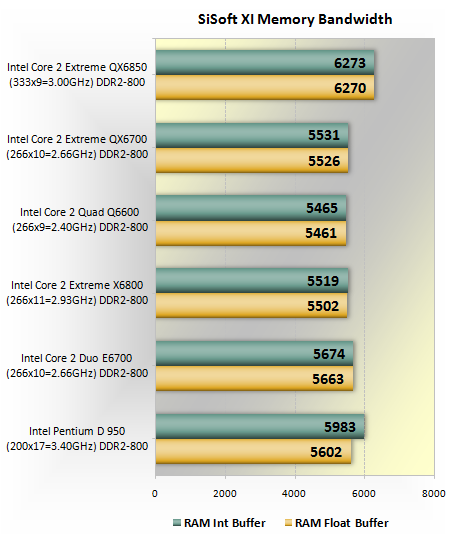System Specs, Memory Performance
Hardware
- Intel Core 2 Extreme QX6850 (3.00GHz) LGA775
- Intel Core 2 Extreme QX6700 (2.66GHz) LGA775
- Intel Core 2 Quad Q6600 (2.40GHz) LGA775
- Intel Core 2 Extreme X6800 (2.93GHz) LGA775
- Intel Core 2 Duo E6700 (2.66GHz) LGA775
- Intel Pentium D 950 (3.40GHz) LGA775
- x2 1024MB Corsair XMS PC-6400 CAS4 Module(s)
- ASUS P5K Deluxe (Intel P35)
- ASUS P5W DH Deluxe (Intel 975X)
- OCZ GameXStream (700 watt)
- Seagate 250GB 7200RPM (Serial ATA II)
- Gigabyte Radeon X1900XTX (512MB)
Software
- Microsoft Windows XP Pro 32bit (SP2)
- ATI Catalyst (6.10)
- Intel System Drivers (7.2.2)

The new Core 2 Extreme QX6850 processor does well in the SiSoft XI memory bandwidth performance test. However this is not because of the speedy four cores, but rather because it uses a quad-pumped 333MHz FSB whereas the other Core 2 processors all use the 266MHz FSB. This allowed the QX6850 to produce around 13% more memory bandwidth than the QX6700.

While the faster FSB of the Core 2 Extreme QX6850 processor did not appear to have much impact on the PCmark2005 write block test, it had a significant impact on the rear performance. Here the new QX6850 was found to be 32% faster than the QX6700.

The MemTach Analyze tests appear to be dictated by core clock frequency rather than FSB speeds or L2 cache capacity. Therefore the Core 2 Extreme QX6850 was only slightly faster than the dual-core Extreme X6800 processor which is clocked just 70MHz slower.